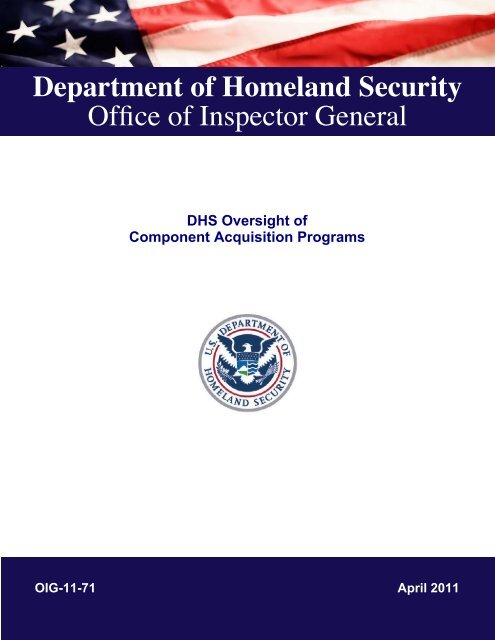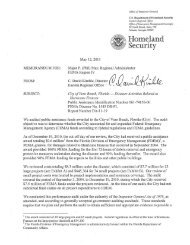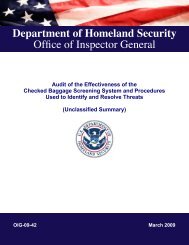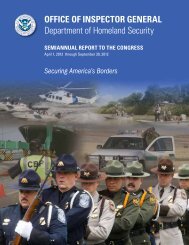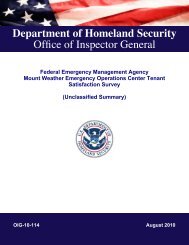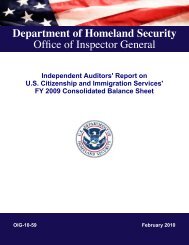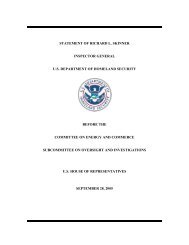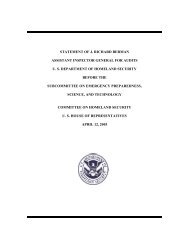DHS Oversight of Component Acquisition Programs - Office of ...
DHS Oversight of Component Acquisition Programs - Office of ...
DHS Oversight of Component Acquisition Programs - Office of ...
Create successful ePaper yourself
Turn your PDF publications into a flip-book with our unique Google optimized e-Paper software.
Department <strong>of</strong> Homeland Security<br />
<strong>Office</strong> <strong>of</strong> Inspector General<br />
<strong>DHS</strong> <strong>Oversight</strong> <strong>of</strong> <br />
<strong>Component</strong> <strong>Acquisition</strong> <strong>Programs</strong> <br />
OIG-11-71 April 2011
<strong>Office</strong> <strong>of</strong>Inspector General<br />
U.S. Department <strong>of</strong> Homeland Security<br />
Washington, DC 20528<br />
APR 11 2011<br />
Homeland<br />
Security<br />
Preface<br />
The Department <strong>of</strong>Homeland Security (<strong>DHS</strong>) <strong>Office</strong> <strong>of</strong>Inspector General (DIG) was<br />
established by the Homeland Security Act <strong>of</strong>2002 (Public Law 107-296) by amendment<br />
to the Inspector General Act <strong>of</strong>1978. This is one <strong>of</strong> a series <strong>of</strong> audit, inspection, and<br />
special reports prepared as part <strong>of</strong> our oversight responsibilities to promote economy,<br />
efficiency, and effectiveness within the department.<br />
This report addresses the strengths and weaknesses <strong>of</strong> the department's acquisition<br />
management process. It is based on interviews with employees and <strong>of</strong>ficials <strong>of</strong> relevant<br />
agencies and institutions, direct observations, and areview <strong>of</strong> applicable documents.<br />
The recommendations herein have been developed to the best knowledge available to our<br />
<strong>of</strong>fice, and have been discussed in draft with those responsible for implementation. We<br />
trust this report will result in more effective, efficient, and economical operations. We<br />
express our appreciation to all <strong>of</strong> those who contributed to the preparation <strong>of</strong> this report.<br />
tI1M-L;;!~<br />
Anne L. Richards<br />
Assistant Inspector General for Audits
Table <strong>of</strong> Contents/Abbreviations <br />
Executive Summary.............................................................................................................1 <br />
Background..........................................................................................................................2 <br />
Results <strong>of</strong> Audit ..................................................................................................................4 <br />
Guidance ........................................................................................................................5 <br />
Available Tools............................................................................................................11 <br />
<strong>Component</strong> Policies and Procedures............................................................................14 <br />
Recommendations..............................................................................................................16 <br />
Management Comments and OIG Analysis ......................................................................16 <br />
Appendixes<br />
Appendix A: Purpose, Scope, and Methodology.......................................................20 <br />
Appendix B: Management Comments to the Draft Report.......................................21 <br />
Appendix C: <strong>Acquisition</strong> <strong>Programs</strong> Reviewed..........................................................28 <br />
Appendix D: <strong>Acquisition</strong> Program Comparison .......................................................29 <br />
Appendix E: <strong>Acquisition</strong> Lifecycle Framework (Directive 102-01) ........................30 <br />
Appendix F: Major Contributors to this Report........................................................31 <br />
Appendix G: Report Distribution ..............................................................................32 <br />
Figures<br />
Figure 1:<br />
Figure 2:<br />
<strong>Component</strong> Budget Authority for Fiscal Years 2006–2010 ..................2 <br />
nPRS Policy Timeline............................................................................9 <br />
Tables<br />
Table 1:<br />
Table 2:<br />
Table 3:<br />
Table 4:<br />
<strong>Acquisition</strong> Program Levels ..................................................................3 <br />
<strong>Acquisition</strong> Program Reporting System Inconsistencies.....................10 <br />
<strong>Acquisition</strong> Program Inconsistencies...................................................10 <br />
<strong>Component</strong> Policies and Procedures....................................................15 <br />
Abbreviations<br />
APMD <strong>Acquisition</strong> Program Management Division <br />
CBP<br />
Customs and Border Protection <br />
COTS commercial <strong>of</strong>f-the-shelf <br />
CPO<br />
Chief Procurement <strong>Office</strong>r <br />
<strong>DHS</strong><br />
Department <strong>of</strong> Homeland Security
Directive 102-01 <strong>Acquisition</strong> Management Directive 102-01, Revision<br />
Number 01<br />
FEMA Federal Emergency Management Agency<br />
FLETC Federal Law Enforcement Training Center<br />
FY<br />
fiscal year<br />
Guidebook <strong>Acquisition</strong> Instruction/Guidebook 102-01-001, Interim Version<br />
1.9 (Nov. 7, 2008)<br />
ICE<br />
Immigration and Customs Enforcement<br />
IT<br />
information technology<br />
nPRS<br />
next Generation Periodic Reporting System<br />
OIG<br />
<strong>Office</strong> <strong>of</strong> Inspector General<br />
SSPO<br />
Strategic Sourcing Program <strong>Office</strong><br />
TSA<br />
Transportation Security Administration<br />
USCIS U.S. Citizenship and Immigration Services<br />
USM<br />
Under Secretary for Management
OIG <br />
Department <strong>of</strong> Homeland Security<br />
<strong>Office</strong> <strong>of</strong> Inspector General<br />
Executive Summary<br />
<strong>Acquisition</strong>s consume a significant part <strong>of</strong> the Department <strong>of</strong><br />
Homeland Security’s annual budget and are fundamental to the<br />
department’s ability to accomplish its mission. The department’s<br />
revised enacted budget authority for fiscal year 2010 is<br />
approximately $55.3 billion, and between October 2009 and<br />
August 2010, it obligated about $9.2 billion for procurement costs.<br />
We performed this audit to determine whether the department<br />
established adequate management oversight and controls over<br />
component acquisition programs.<br />
The department has generally made progress in its acquisition<br />
oversight processes and controls through implementation <strong>of</strong> a<br />
revised acquisition management directive. However, the department<br />
needs to further refine its guidance by providing additional detailed<br />
guidance and improving controls in some areas. The department has<br />
not fully defined, for its components, what constitutes an acquisition<br />
program, or developed consistent guidance for reporting acquisition<br />
programs in its standard reporting system. In addition, the<br />
department did not ensure that components were using all<br />
acquisition tools available and that all components had adequate<br />
policies and procedures in place to manage acquisition programs.<br />
As a result, components created program management <strong>of</strong>fices to<br />
manage simple procurements, incurring unnecessary administrative<br />
program costs without adding value to the programs. Additionally,<br />
without adequate controls in place, the department did not have<br />
complete visibility <strong>of</strong> all programs within its acquisition portfolio.<br />
We made four recommendations to the Chief Procurement <strong>Office</strong>r<br />
to strengthen the department’s management oversight and controls<br />
over component acquisition programs. The Chief Procurement<br />
<strong>Office</strong>r agreed with our recommendations and initiated corrective<br />
actions.<br />
<strong>DHS</strong> <strong>Oversight</strong> <strong>of</strong> <strong>Component</strong> <strong>Acquisition</strong> <strong>Programs</strong> <br />
Page 1
Background<br />
The Department <strong>of</strong> Homeland Security (<strong>DHS</strong>) continues to face<br />
challenges associated with implementing a fully integrated<br />
acquisition function. A successful acquisition process requires an<br />
effective acquisition management infrastructure. <strong>Acquisition</strong><br />
management is a complex process that goes beyond simply<br />
awarding a contract. It begins with the identification <strong>of</strong> a mission<br />
need; continues with the development <strong>of</strong> a strategy to fulfill that<br />
need while balancing cost, schedule, and performance; and<br />
concludes with contract closeout after satisfactorily meeting the<br />
terms. <strong>Acquisition</strong> management includes managing operational<br />
and life cycle requirements—from formulating concepts <strong>of</strong><br />
operations, developing sound business strategies, and exercising<br />
prudent financial management to assessing trade<strong>of</strong>fs and managing<br />
program risks.<br />
The department’s revised enacted budget authority for fiscal year<br />
(FY) 2010 is approximately $55.3 billion. Between October 2009<br />
and August 2010, the department obligated about $9.2 billion in<br />
procurement cost, <strong>of</strong> its total $55.3 billion. <strong>DHS</strong>’s total budget<br />
authority increased from about $40.3 billion in 2006 to about $55.3<br />
billion in 2010, an increase <strong>of</strong> about 37%, excluding any<br />
supplemental funding and rescissions <strong>of</strong> prior-year carryover<br />
funds. Figure 1 illustrates the components’ budget authority for<br />
the past 5 years.<br />
Figure 1. <strong>Component</strong> Budget Authority for Fiscal Years 2006–2010<br />
$14,000,000,000<br />
$12,000,000,000<br />
$10,000,000,000<br />
$8,000,000,000<br />
$6,000,000,000<br />
$4,000,000,000<br />
CBP<br />
ICE<br />
TSA<br />
CG<br />
USSS<br />
FEMA & FEMA (Grants <strong>Programs</strong>)<br />
CIS<br />
FLETC<br />
**Does not include all components<br />
$2,000,000,000<br />
$-<br />
2010 2009 2008 2007 2006<br />
Year<br />
<strong>DHS</strong> <strong>Oversight</strong> <strong>of</strong> <strong>Component</strong> <strong>Acquisition</strong> <strong>Programs</strong><br />
Page 2
Recognizing the continued increase in the quantity and complexity<br />
<strong>of</strong> acquisitions supporting its missions, the department prescribed<br />
additional guidance for acquisition management and oversight<br />
beginning in November 2008. The Chief <strong>Acquisition</strong> <strong>Office</strong>r<br />
classified acquisitions into three levels to define the extent and<br />
scope <strong>of</strong> required project and program management and the<br />
specific <strong>of</strong>ficial 1 who serves as the <strong>Acquisition</strong> Decision Authority.<br />
Table 1 lists these levels.<br />
Table 1: <strong>Acquisition</strong> Program Levels<br />
Lifecycle Cost<br />
<strong>Acquisition</strong> Decision Authority*<br />
Level 1 Greater than or equal to $1 billion Deputy Secretary<br />
Level 2 $300 million to $1 billion Chief <strong>Acquisition</strong> <strong>Office</strong>r<br />
Level 3 Less than $300 million <strong>Component</strong> Head<br />
*Refer to footnote below.<br />
The following entities within <strong>DHS</strong> have a role in managing and<br />
overseeing acquisition programs:<br />
• Chief <strong>Acquisition</strong> <strong>Office</strong>r – Responsible for managing,<br />
administering, and overseeing the department’s acquisition<br />
policies and procedures. The Under Secretary for<br />
Management (USM) is currently the Chief <strong>Acquisition</strong><br />
<strong>Office</strong>r who designates <strong>Component</strong> <strong>Acquisition</strong> Executives.<br />
• <strong>Component</strong> Heads – Oversee acquisitions within their<br />
component in accordance with the department’s acquisition<br />
policies and procedures, and ensure sound management,<br />
review, support, approval, and oversight <strong>of</strong> all types <strong>of</strong><br />
acquisitions within the component.<br />
• <strong>Acquisition</strong> Decision Authority – Department and<br />
component <strong>of</strong>ficials responsible for ensuring compliance<br />
with <strong>Acquisition</strong> Management Directive 102-01, Revision<br />
Number 01 (Directive 102-01) by reviewing and approving<br />
the movement <strong>of</strong> acquisitions through the phases <strong>of</strong> the<br />
acquisition life cycle upon satisfaction <strong>of</strong> applicable criteria<br />
at an <strong>Acquisition</strong> Review Board.<br />
• <strong>Acquisition</strong> Review Board – Cross-component board within<br />
the department that determines whether a proposed<br />
acquisition has met the requirements <strong>of</strong> key phases in the<br />
<strong>Acquisition</strong> Lifecycle Framework and is able to proceed to<br />
the next phase. The <strong>Acquisition</strong> Review Board is composed<br />
1 The <strong>Acquisition</strong> Decision Authority may designate his or her responsibilities to other <strong>of</strong>ficials.<br />
<strong>DHS</strong> <strong>Oversight</strong> <strong>of</strong> <strong>Component</strong> <strong>Acquisition</strong> <strong>Programs</strong> <br />
Page 3
Results <strong>of</strong> Audit<br />
<strong>of</strong> <strong>of</strong>ficials that the <strong>Acquisition</strong> Decision Authority<br />
determines to be knowledgeable <strong>of</strong> the subject matter.<br />
• <strong>Component</strong> <strong>Acquisition</strong> Executives – Senior acquisition<br />
<strong>of</strong>ficials within a component responsible for implementing,<br />
managing, and overseeing their component’s acquisition<br />
processes. <strong>Component</strong> <strong>Acquisition</strong> Executives coordinate<br />
contracting and procurement processes with the<br />
component’s Head <strong>of</strong> Contracting Activity.<br />
• Director, <strong>Acquisition</strong> Program Management Division<br />
(APMD) – Responsible for developing and maintaining<br />
acquisition policy, procedures, and guidance, as well as<br />
assisting the Chief <strong>Acquisition</strong> <strong>Office</strong>r in the management<br />
<strong>of</strong> the department’s acquisition portfolio.<br />
On May 26, 2010, the USM issued the department’s latest Major<br />
<strong>Acquisition</strong> <strong>Oversight</strong> List. The list identified 86 major acquisition<br />
programs, projects, and services requiring direct departmental<br />
oversight. The department oversees acquisition programs at or<br />
above $300 million 2 in life cycle cost. <strong>Component</strong>s are responsible<br />
for the oversight and controls for acquisition programs below the<br />
$300 million threshold.<br />
<strong>DHS</strong> generally had management oversight and controls in place over components’<br />
acquisition programs. In January 2010, the department issued Revision Number<br />
01 to its interim Directive 102-01 directive, which prescribed guidance over the<br />
<strong>Acquisition</strong> Review Process, <strong>Acquisition</strong> Lifecycle Framework, and <strong>Acquisition</strong><br />
Review Board. It also issued a supplemental <strong>Acquisition</strong> Instruction/Guidebook<br />
102-01-001, Version 1.9 (November 7, 2008) (Guidebook) to the interim directive<br />
that provided detailed instructions on implementing and managing acquisition<br />
management. The Directive and Guidebook addressed many <strong>of</strong> the oversight and<br />
control problems previously identified regarding acquisition management.<br />
Directive 102-01 and the Guidebook were positive steps, but the department can<br />
do more.<br />
The department needs to further refine policies in some areas and strengthen<br />
oversight in others. Some components were creating program management<br />
<strong>of</strong>fices to manage simple procurements, not properly reporting programs into the<br />
standard system, or not applying strategic sourcing strategies to support program<br />
development. Additionally, not all components developed component-level<br />
2 The <strong>Acquisition</strong> Review Board can elevate acquisition program levels based on five exceptions listed in<br />
Directive 102-01.<br />
<strong>DHS</strong> <strong>Oversight</strong> <strong>of</strong> <strong>Component</strong> <strong>Acquisition</strong> <strong>Programs</strong> <br />
Page 4
acquisition policies and procedures to manage their programs. As a result, some<br />
components unnecessarily created acquisition programs, which potentially<br />
increased administrative costs without adding value to the programs, and the<br />
department does not always know what is in its acquisition portfolio.<br />
Guidance<br />
The department did not fully define, for its components, what should<br />
constitute an acquisition program or develop consistent guidance for<br />
reporting requirements into its standard reporting system. The department<br />
did not provide consistent acquisition program reporting guidance for the<br />
use <strong>of</strong> the next Generation Periodic Reporting System (nPRS). As a<br />
result, component personnel, motivated to implement and follow<br />
department guidance, unnecessarily created acquisition programs that<br />
potentially incurred additional program management costs and distorted<br />
the position <strong>of</strong> the department’s acquisition portfolio. <strong>Component</strong>s further<br />
distorted the acquisition portfolio position by inconsistently reporting<br />
programs into nPRS.<br />
Directive 102-01<br />
The department has not fully defined when a component should<br />
manage an acquisition under the requirements <strong>of</strong> the <strong>Acquisition</strong><br />
Lifecycle Framework or manage it as a simple procurement. We<br />
found that many components were committed to following the<br />
department’s guidance but needed more structure for determining<br />
when to establish a program to acquire a product or service. We<br />
requested a list <strong>of</strong> all programs from each component and received<br />
numerous questions and conflicting responses. For example:<br />
• Immigration and Customs Enforcement (ICE) personnel<br />
stated that they were having problems identifying level 3<br />
acquisition programs because they believed that Directive<br />
102-01 did not adequately define an acquisition program.<br />
In May 2010, ICE personnel provided a preliminary list <strong>of</strong><br />
their acquisition programs, but as <strong>of</strong> October 1, 2010, they<br />
had not provided a final list.<br />
• Science and Technology personnel asked the audit team if<br />
they should include the funding and conducting <strong>of</strong> research<br />
and development programs or projects as acquisition<br />
programs. They specifically questioned whether they<br />
should manage the First Responder websites they operate<br />
and maintain as acquisition programs.<br />
<strong>DHS</strong> <strong>Oversight</strong> <strong>of</strong> <strong>Component</strong> <strong>Acquisition</strong> <strong>Programs</strong> <br />
Page 5
• Domestic Nuclear Detection <strong>Office</strong> personnel asked if there<br />
were details that explained which acquisitions were or were<br />
not programs. They stated that the definition for<br />
acquisition programs is so broad that they were unsure<br />
whether the small contracts for services were level 3<br />
acquisition programs.<br />
• Transportation Security Administration (TSA) personnel<br />
stated that they classified all acquisitions that appeared to<br />
be programs as acquisition programs because the definition<br />
was unclear.<br />
• Federal Emergency Management Agency (FEMA)<br />
personnel were uncertain whether to classify large service<br />
contracts as acquisition programs. Initially, when we<br />
requested a list <strong>of</strong> FEMA’s programs, FEMA personnel<br />
stated that they could not provide a complete list <strong>of</strong><br />
programs for 6 to 12 months. Senior personnel explained<br />
that FEMA was in the process <strong>of</strong> reorganizing its acquisition<br />
management function. After meeting with senior<br />
management personnel, toward the end <strong>of</strong> audit fieldwork,<br />
we received a draft list <strong>of</strong> programs, but as <strong>of</strong> October 1,<br />
2010, FEMA personnel had not provided a final list.<br />
Directive 102-01 establishes the overall policy and structure for<br />
acquisition management within the department, but does not<br />
provide a decision-making tool to determine if an acquisition<br />
warrants the higher level <strong>of</strong> internal controls required by the<br />
<strong>Acquisition</strong> Lifecycle Framework. According to the glossary <strong>of</strong><br />
the Guidebook, an acquisition program is the totality <strong>of</strong> activities<br />
directed to accomplish a program to acquire or support/sustain<br />
capabilities, funded through one or more investments. In contrast,<br />
the Guidebook defines an acquisition as the conceptualization,<br />
initiation, design, development, test, contracting, production,<br />
deployment, logistics support, modification, and disposal <strong>of</strong><br />
systems, supplies, or services (including construction) to satisfy<br />
<strong>DHS</strong> needs. To complicate the definitions further, the body <strong>of</strong> the<br />
Guidebook states that capital assets, enterprise/component-level<br />
service contracts, interagency agreements, and strategically<br />
sourced acquisitions will follow Directive 102-01.<br />
These definitions do not provide clear instruction for determining<br />
if an acquisition should become an acquisition program, and in<br />
attempts to comply with the directive, components over classified<br />
programs. For example, the Federal Law Enforcement Training<br />
Center (FLETC) is automating many <strong>of</strong> its manual processes, such<br />
<strong>DHS</strong> <strong>Oversight</strong> <strong>of</strong> <strong>Component</strong> <strong>Acquisition</strong> <strong>Programs</strong> <br />
Page 6
as student registration, class scheduling, planning and forecasting,<br />
and student records. The estimated total life cycle cost <strong>of</strong> this<br />
automation is approximately $30 million. FLETC personnel<br />
contracted out all <strong>of</strong> the requirements for the program, including<br />
requirements analysis, development, and maintenance <strong>of</strong> an<br />
automated system that used commercial <strong>of</strong>f-the-shelf (COTS)<br />
equipment and custom s<strong>of</strong>tware applications. Because <strong>of</strong> the<br />
unclear instructions, instead <strong>of</strong> creating a simple procurement,<br />
FLETC created an acquisition program that may have<br />
unnecessarily increased program management administrative cost.<br />
We reviewed several acquisition programs that do not clearly fit<br />
into the <strong>Acquisition</strong> Lifecycle Framework process. Ten <strong>of</strong> the 17<br />
(59%) programs we reviewed, with an estimated life cycle cost <strong>of</strong><br />
about $5.3 billion, were acquisitions that identified COTS<br />
equipment or existing contracts to fulfill the needs identified by the<br />
program <strong>of</strong>fice. <strong>Component</strong> personnel likely could have managed<br />
these as simple procurements rather than acquisition programs.<br />
For example, TSA classified renovation <strong>of</strong> an existing warehouse<br />
building as an acquisition program. It leased the 104,000-squarefoot<br />
building in 2003 and renovated approximately 89,000 square<br />
feet for about $42 million over the initial 10-year leasing period.<br />
In 2008, TSA primarily relied on existing contracts to complete<br />
12,500 <strong>of</strong> the remaining 15,000 square feet <strong>of</strong> the warehouse<br />
building. According to TSA personnel, the renovation for the<br />
additional 12,500 square feet cost about $2.5 million, with<br />
construction completed in January 2010. For this small renovation<br />
project, TSA personnel could have used simple procurement rules<br />
but instead increased administrative costs by implementing the<br />
more complicated internal control structure prescribed in Directive<br />
102-01.<br />
Based on the definition <strong>of</strong> an acquisition program in the<br />
Guidebook, this renovation could possibly be an acquisition<br />
program. However, based on the processes and procedures laid out<br />
in Directive 102-01’s <strong>Acquisition</strong> Lifecycle Framework and<br />
<strong>Acquisition</strong> Review Process, this renovation does not clearly meet<br />
the intentions <strong>of</strong> the existing guidance or present a high level <strong>of</strong><br />
risk to warrant the increased costs <strong>of</strong> being managed as a program.<br />
<strong>Component</strong>s should not create acquisition programs for acquiring<br />
products and services under a simple procurement action that are<br />
outside the intent and spirit <strong>of</strong> Directive 102-01. The department<br />
can reduce some <strong>of</strong> the conflicts at the component level by<br />
developing a decision matrix that the components can apply in the<br />
pre-planning phases <strong>of</strong> the purchasing process.<br />
<strong>DHS</strong> <strong>Oversight</strong> <strong>of</strong> <strong>Component</strong> <strong>Acquisition</strong> <strong>Programs</strong> <br />
Page 7
nPRS Reporting Guidance<br />
The department developed inconsistent reporting requirements for<br />
components to follow when reporting an acquisition’s progress in<br />
the department’s standard reporting system. nPRS is an integrated<br />
system that provides visibility to the department to track<br />
components’ level 1, 2, and 3 acquisition investments. It also has<br />
capabilities to store working and approved key acquisition<br />
documents, earned value management information, and risk<br />
identification. <strong>Component</strong> personnel are responsible for entering<br />
and updating information regarding their acquisition programs in<br />
nPRS. This information includes, but is not limited to, cost,<br />
budget, performance, and schedule data.<br />
For the 17 acquisition programs we reviewed, with an estimated<br />
life cycle cost <strong>of</strong> about $9.6 billion, we found that components<br />
were not completing and reporting all key information in nPRS.<br />
<strong>Component</strong> personnel input 16 <strong>of</strong> 17 programs reviewed (94%)<br />
into nPRS; however, despite detailed nPRS guidance, not all<br />
programs contained the required information. For example, only 7<br />
<strong>of</strong> 17 programs (41%) reported <strong>Acquisition</strong> Program Baseline<br />
required milestones, which establish the overall acquisition cost,<br />
schedule, and performance values. Only 13 (76%) programs<br />
reviewed contained required key documentation. Key documents<br />
include the mission needs statement, acquisition plan, operational<br />
requirements document, integrated logistics support plan, and the<br />
acquisition program baseline.<br />
Since nPRS became operational in 2008, the department has issued<br />
conflicting guidance and enforcement for reporting level 1, 2, and<br />
3 acquisition programs. According to APMD personnel, level 1<br />
and 2 acquisition programs are the only programs that require<br />
nPRS reporting, while reporting level 3 acquisition programs is<br />
optional. Despite APMD personnel’s explanation <strong>of</strong> the nPRS<br />
reporting requirements, in November 2008 they required level 1, 2,<br />
and 3 acquisitions to follow the <strong>DHS</strong> periodic reporting process<br />
identified in the nPRS manual. Then in May 2009, the USM<br />
issued a memorandum requiring major acquisition programs, level<br />
1 and 2, to transition to nPRS by the end <strong>of</strong> the month. In July<br />
2009, the <strong>Office</strong> <strong>of</strong> the Chief Information <strong>Office</strong>r issued guidance<br />
that required components to report all programs to nPRS. In<br />
September 2009, the Director <strong>of</strong> APMD issued a memorandum<br />
designating nPRS as the department’s system <strong>of</strong> record for<br />
acquisition management data and <strong>of</strong>ficial reporting system for all<br />
level 1, 2, and 3 acquisition programs. In January 2010, the<br />
<strong>DHS</strong> <strong>Oversight</strong> <strong>of</strong> <strong>Component</strong> <strong>Acquisition</strong> <strong>Programs</strong> <br />
Page 8
APMD issued the final Directive 102-01, which required all level<br />
1, 2, and 3 acquisition programs to comply with the <strong>DHS</strong> periodic<br />
reporting process. This conflicting verbal and written guidance<br />
confused component personnel, who were not sure whether to<br />
report all acquisition programs or only level 1 and 2 programs.<br />
Figure 2 depicts the timeline <strong>of</strong> conflicting nPRS reporting<br />
guidance.<br />
Figure 2. nPRS Policy Timeline<br />
In May 2010, the USM issued a list <strong>of</strong> major acquisition programs<br />
that identified 86 level 1 and 2 acquisition programs and elevated<br />
some level 3 acquisition programs for departmental oversight.<br />
According to APMD personnel, the department and components<br />
jointly create the major acquisition program and project list. The<br />
APMD obtains information from nPRS and requests updated<br />
information from the components regarding their current number<br />
<strong>of</strong> acquisition programs. Once APMD personnel receive the<br />
information, they create the final list and the USM signs and issues<br />
the new list.<br />
As <strong>of</strong> July 2010, we identified six acquisition programs listed on<br />
the USM letter, but components did not report them in nPRS. We<br />
also identified five level 1 and 2 acquisition programs reported in<br />
nPRS but not on the USM letter. When we questioned department<br />
personnel about the differences between the USM letter and nPRS,<br />
they stated that the differences were due to timing issues.<br />
However, we were not able to reconcile the differences to verify<br />
that they were timing related. Table 2 compares the list <strong>of</strong><br />
acquisition programs in the May 2010 USM memo with the nPRS<br />
database as <strong>of</strong> July 2010.<br />
<strong>DHS</strong> <strong>Oversight</strong> <strong>of</strong> <strong>Component</strong> <strong>Acquisition</strong> <strong>Programs</strong> <br />
Page 9
Table 2. <strong>Acquisition</strong> Program Reporting System Inconsistencies<br />
USM Memo - May 2010 nPRS Database - July 2010<br />
Consolidated Mail System Program<br />
No Entry<br />
Electronic Records Management System<br />
No Entry<br />
St. Elizabeth's<br />
No Entry<br />
National Security System Program<br />
No Entry<br />
Online Tracking Information System<br />
No Entry<br />
Federal Protective Services<br />
No Entry<br />
No Entry<br />
No Entry<br />
No Entry<br />
No Entry<br />
No Entry<br />
Critical Infrastructure<br />
Technology and Analysis<br />
CBP - Infrastructure<br />
FEMA - Infrastructure<br />
ICE - Infrastructure<br />
USSS - Infrastructure<br />
To identify the number <strong>of</strong> acquisition programs in the department,<br />
we requested a list <strong>of</strong> all programs from nPRS, but the department<br />
could provide only level 1 and 2 acquisition programs. In March<br />
2010, we requested that the components provide us with a list <strong>of</strong><br />
all level 1, 2, and 3 acquisition programs so we could gain a<br />
complete inventory <strong>of</strong> acquisition programs throughout the<br />
department. Table 3 shows some inconsistencies between the<br />
department’s totals and the components’ totals.<br />
Table 3. <strong>Acquisition</strong> Program Inconsistencies<br />
Level 1<br />
Level 2<br />
Level 3<br />
Total<br />
DE P A R T M E NT<br />
USM Letter - Apr 23, 2009 42 25 0 67<br />
nPRS datapull March 2010 43 20 0 63<br />
USM Letter - May 26, 2010 46 40 0 86<br />
nPRS datapull June 2010 49 33 0 82<br />
nPRS datapull July 2010 50 32 70 152<br />
CO M PO N E N T S 48 22 152 222<br />
**See Appendix D for the detailed spreadsheet.<br />
We obtained the department’s totals at five different times. Though<br />
we understand that there may be differences in timing due to the<br />
intervals, the department needs to make sure that components are<br />
consistently reporting all acquisition programs into the standard<br />
system. In July 2010, we obtained our last data from nPRS that<br />
showed progress regarding the number <strong>of</strong> level 3 acquisition<br />
<strong>DHS</strong> <strong>Oversight</strong> <strong>of</strong> <strong>Component</strong> <strong>Acquisition</strong> <strong>Programs</strong> <br />
Page 10
Available Tools<br />
programs components entered in the system. However, nPRS still<br />
does not reflect half <strong>of</strong> the total number <strong>of</strong> level 3 programs<br />
components reported outside nPRS.<br />
The department does not always know what is in its acquisition<br />
portfolio because <strong>of</strong> the conflicting written and verbal guidance<br />
provided to the components. The department has not ensured that<br />
components report all level 1, 2, and 3 acquisition programs in<br />
nPRS, which hinders its ability to have complete visibility into<br />
components acquisition programs. By mandating use <strong>of</strong> nPRS for<br />
all acquisition programs, the department would have visibility into<br />
components’ acquisition programs and could provide better<br />
oversight for its acquisition portfolio.<br />
The department has not ensured or mandated that components use all<br />
available tools and supporting programs, including nPRS and the<br />
department’s Strategic Sourcing Program <strong>Office</strong> (SSPO), to provide<br />
transparency and efficiency <strong>of</strong> component acquisition programs. As a<br />
result, some components have developed systems comparable to nPRS and<br />
may have awarded contracts without consideration <strong>of</strong> the SSPO.<br />
nPRS Tools<br />
The department, in conjunction with the APMD and the <strong>Office</strong> <strong>of</strong><br />
the Chief Information <strong>Office</strong>r, developed and currently maintain<br />
nPRS. nPRS manages the department’s level 1, 2, and 3<br />
acquisition programs by incorporating numerous tools for the<br />
department and components to provide oversight and visibility.<br />
Tools available within nPRS include the following:<br />
• Current and previous contract award data with earned value<br />
management<br />
• Previous, current, and future budget and funding<br />
• Cost, schedule, and performance status based on<br />
<strong>Acquisition</strong> Program Baseline parameters<br />
• Information technology program milestone schedule and<br />
cost variances<br />
• <strong>Acquisition</strong> Decision Memorandum forms that track action<br />
items issued by the <strong>Acquisition</strong> Review Board<br />
• Key documents approved by the department or component,<br />
such as the Mission Needs Statement, <strong>Acquisition</strong> Plan, and<br />
<strong>Acquisition</strong> Program Baseline<br />
<strong>DHS</strong> <strong>Oversight</strong> <strong>of</strong> <strong>Component</strong> <strong>Acquisition</strong> <strong>Programs</strong> <br />
Page 11
According to APMD personnel, nPRS allows components to create<br />
a copy <strong>of</strong> nPRS s<strong>of</strong>tware and integrate it to meet the components’<br />
needs. The copy, which is called the nPRS Sandbox, allows the<br />
components to duplicate the department’s copy <strong>of</strong> the nPRS<br />
s<strong>of</strong>tware and to use the already developed nPRS as their oversight<br />
tool for draft documents, component approval process for<br />
documentation, earned value management, as well as cost and<br />
schedule status. The component’s Sandbox copy <strong>of</strong> nPRS is not<br />
visible by the department or other components because nPRS<br />
restricts access to unauthorized users. As <strong>of</strong> July 2010, three<br />
components had requested use <strong>of</strong> the nPRS Sandbox feature: TSA,<br />
FEMA, and the <strong>DHS</strong> Chief Financial <strong>Office</strong>.<br />
<strong>Component</strong> personnel have developed, or they are in the process <strong>of</strong><br />
developing, their own data-tracking systems because the<br />
department has not consistently mandated use <strong>of</strong> nPRS or its tools<br />
within the system. For example:<br />
• TSA hired and spent approximately $100,000 for a<br />
contractor in 2005 to develop the TSA <strong>Acquisition</strong> Program<br />
Status Report, which served as its data-tracking system. As<br />
<strong>of</strong> June 2010, TSA had merged its acquisition program<br />
portfolio, levels 1, 2, and 3, into the department’s nPRS and<br />
will no longer report to the TSA <strong>Acquisition</strong> Program<br />
Status Report. As <strong>of</strong> August 2010, nPRS will be its <strong>of</strong>ficial<br />
tracking system for acquisition programs.<br />
• Customs and Border Protection (CBP) personnel were in<br />
the process <strong>of</strong> developing a database to track acquisitions<br />
throughout the <strong>Acquisition</strong> Lifecycle Framework. We were<br />
not able to determine the cost <strong>of</strong> this tracking database.<br />
According to CBP personnel, the database was a verbal<br />
agreement between CBP personnel and the contractor for<br />
the development and tracking <strong>of</strong> the database. The<br />
statement <strong>of</strong> work did not contain any mention <strong>of</strong> the verbal<br />
agreement.<br />
• FEMA, CBP, ICE, and U.S. Secret Service use internally<br />
developed systems based on s<strong>of</strong>tware programs such as<br />
Micros<strong>of</strong>t SharePoint.<br />
The department has not consistently mandated and ensured that<br />
components use nPRS for all level 1, 2, and 3 acquisition programs.<br />
<strong>DHS</strong> <strong>Oversight</strong> <strong>of</strong> <strong>Component</strong> <strong>Acquisition</strong> <strong>Programs</strong> <br />
Page 12
Strategic Sourcing Program <strong>Office</strong><br />
The department has not ensured that the components use the SSPO<br />
when managing acquisition programs. Directive 102-01 and the<br />
Information Technology Integration and Management Directive,<br />
MD 0007.1, do not require components to consider the SSPO when<br />
planning for acquisition programs. The department created the<br />
SSPO, within the <strong>Office</strong> <strong>of</strong> the Chief Procurement <strong>Office</strong>r, to help<br />
components do the following:<br />
• Identify best prices available for a requirement<br />
• Engage in market research to identify the best available<br />
vendors and manufacturers<br />
• Minimize duplication <strong>of</strong> effort for market research<br />
• Provide department-wide contract vehicles<br />
Of the 17 component acquisition programs we reviewed, 10 (with<br />
an estimated life cycle cost <strong>of</strong> about $5.3 billion) were acquisition<br />
programs that component personnel awarded or plan to award<br />
contracts for the procurement and development <strong>of</strong> COTS s<strong>of</strong>tware<br />
and equipment. Six <strong>of</strong> the 10 programs (with an estimated life cycle<br />
cost <strong>of</strong> about $5.1 billion) relied on a department-wide contract for<br />
some or all <strong>of</strong> their procurement needs, and components awarded or<br />
will award 3 programs (with an estimated life cycle cost <strong>of</strong> about<br />
$.19 billion) to vendors outside the department-wide strategically<br />
sourced contracts. The remaining program was in the analyze/select<br />
phase and the component had not determined which procurement<br />
mechanism to use.<br />
<strong>Component</strong>s did not consider the SSPO when planning and<br />
awarding procurements. For example, FLETC personnel created<br />
an acquisition program to provide electronic training materials.<br />
FLETC used a Small Business Administration 8(a) contractor to<br />
procure some <strong>of</strong> its requirements, but it did not use a General<br />
Services Administration vendor to procure its COTS equipment. If<br />
FLETC had used a General Services Administration vendor to<br />
procure its COTS equipment, it might have saved resources.<br />
However, it can benefit from the future department-wide contract<br />
for its wireless communication requirements.<br />
The SSPO identified five future department-wide contracts for<br />
acquiring canines, dog supplies, dog food, veterinary care, and<br />
explosive training aids and storage. TSA established an<br />
acquisition program to use canines and handlers to deter and detect<br />
the introduction <strong>of</strong> explosives into the transportation system.<br />
<strong>DHS</strong> <strong>Oversight</strong> <strong>of</strong> <strong>Component</strong> <strong>Acquisition</strong> <strong>Programs</strong> <br />
Page 13
However, TSA is not required to consider using the SSPO<br />
contracts to purchase these canine requirements, which may<br />
increase procurement costs.<br />
Because the current guidance is silent regarding the use <strong>of</strong> the<br />
SSPO, the department may be incurring increased cost for<br />
component procurements. In addition, components may be<br />
conducting duplicative market research for procurements that the<br />
SSPO has performed. The department should make sure<br />
component personnel are at least considering use <strong>of</strong> the SSPO<br />
during the planning stages <strong>of</strong> their acquisition programs before<br />
awarding any contracts.<br />
<strong>Component</strong> Policies and Procedures<br />
The department has not taken steps to ensure that all components have<br />
developed prescribed policies and procedures for oversight <strong>of</strong> acquisition<br />
programs. Directive 102-01 states that components retain the authority to<br />
set internal acquisition processes and procedures, as long as they are<br />
consistent with the spirit and intent <strong>of</strong> the directive. However, not all<br />
components have created such policies and procedures, and the<br />
department has not taken steps to ensure the adequacy <strong>of</strong> the processes and<br />
procedures that components developed.<br />
We performed a department-wide review <strong>of</strong> component policies and<br />
procedures regarding acquisition management. As depicted in Table 4,<br />
four components have created and issued finalized policies, five have draft<br />
policies, and three were not able to provide any policies or procedures.<br />
<strong>DHS</strong> <strong>Oversight</strong> <strong>of</strong> <strong>Component</strong> <strong>Acquisition</strong> <strong>Programs</strong> <br />
Page 14
Table 4. <strong>Component</strong> Policies and Procedures<br />
<strong>Component</strong> Finalized Draft<br />
Unable<br />
to<br />
Provide<br />
Transportation Security Administration 9<br />
United States Coast Guard 9<br />
National Protection and <strong>Programs</strong><br />
9<br />
Directorate<br />
Domestic Nuclear Detection <strong>Office</strong> 9<br />
Federal Law Enforcement Training Center 9*<br />
Customs and Border Protection 9<br />
United States Secret Service 9<br />
Federal Emergency Management Agency 9<br />
U.S. Citizenship and Immigration<br />
9**<br />
Services (USCIS)<br />
Immigration and Customs Enforcement 9<br />
<strong>Office</strong> <strong>of</strong> Health Affairs 9<br />
Science and Technology 9<br />
*FLETC has issued System Engineering Life Cycle policy, but not acquisition <br />
management policy. <br />
**USCIS has issued procurement policy, but not acquisition management policy. <br />
The department prematurely gave approval authority in Directive 102-01<br />
for level 3 acquisition programs without ensuring that components’<br />
policies and procedures were in place and operating effectively. For the<br />
six components in our file review—<br />
• Two (33%) have finalized policies.<br />
• Three (50%) have draft policies.<br />
• One (17%) does not have any policy.<br />
In addition, components are not always following prescribed department<br />
or component guidance. For example, FLETC requested funding for one<br />
<strong>of</strong> its level 3 acquisition programs through the <strong>Office</strong> <strong>of</strong> Management and<br />
Budget in 2006. According to component personnel, the department<br />
denied the request but intended for the component to execute a pilot<br />
program. If the pilot program succeeded, the program <strong>of</strong>fice would<br />
request additional funding from the department. The component went<br />
forward, created a pilot program, and is currently procuring equipment and<br />
foresees that the pilot program will be a success. If the department<br />
approves the pilot program and provides additional funding, the<br />
acquisition program will proceed without having to perform any<br />
formalized acquisition management. This would not comply with the<br />
requirements <strong>of</strong> Directive 102-01.<br />
<strong>DHS</strong> <strong>Oversight</strong> <strong>of</strong> <strong>Component</strong> <strong>Acquisition</strong> <strong>Programs</strong> <br />
Page 15
The department must ensure that components are in full compliance with<br />
departmental guidance. Because the department gave approval authority<br />
to the components for level 3 programs, it should implement a plan <strong>of</strong><br />
action, with deadlines, for components to complete finalized acquisition<br />
management policies and procedures.<br />
Recommendations<br />
We recommend that the Chief Procurement <strong>Office</strong>r:<br />
Recommendation #1: Develop a decision matrix tool that guides<br />
components on identifying when to apply life cycle management<br />
processes to acquisitions.<br />
Recommendation #2: Direct components to report all acquisition<br />
programs (levels 1, 2, and 3) to nPRS.<br />
Recommendation #3: Require all components to consider using<br />
the Strategic Sourcing Program <strong>Office</strong>, General Services<br />
Administration Schedule, and department-wide contracts in the<br />
planning phase <strong>of</strong> an acquisition program.<br />
Recommendation #4: Implement a plan <strong>of</strong> action or completion<br />
deadline for department-wide finalization <strong>of</strong> acquisition<br />
management policies and procedures.<br />
Management Comments and OIG Analysis<br />
The Deputy Chief Procurement <strong>Office</strong>r (CPO) provided comments<br />
on a draft <strong>of</strong> this report. A copy <strong>of</strong> the comments in their entirety<br />
is included in Appendix B. The CPO concurred with the<br />
recommendations in the report.<br />
Management Comments to Recommendation #1<br />
The CPO concurred with the recommendation. During FY 2011,<br />
APMD will develop a decision matrix tool to guide components on<br />
identifying when to apply life cycle management processes to<br />
acquisitions.<br />
OIG Analysis: The CPO’s actions are responsive to the<br />
recommendation. The decision matrix tool will help component<br />
personnel determine when to follow simple procurement rules rather<br />
than creating acquisition programs that follow the acquisition<br />
<strong>DHS</strong> <strong>Oversight</strong> <strong>of</strong> <strong>Component</strong> <strong>Acquisition</strong> <strong>Programs</strong> <br />
Page 16
lifecycle framework. The recommendation is resolved, but will<br />
remain open until the CPO provides a copy <strong>of</strong> the decision matrix.<br />
Management Comments to Recommendation #2<br />
The CPO concurred with the recommendation. By April 30,<br />
APMD will issue guidance to components that will require<br />
inclusion <strong>of</strong> all level 1, 2, and 3 acquisition programs within the<br />
nPRS tracking tool.<br />
OIG Analysis: The CPO’s actions are responsive to the<br />
recommendation. APMD’s revised guidance will allow the<br />
department to provide better oversight <strong>of</strong> its acquisition portfolio<br />
and ensure complete visibility into components’ acquisition<br />
programs. The recommendation is resolved, but will remain open<br />
until the CPO provides a copy <strong>of</strong> the guidance that requires level 1,<br />
2, and 3, acquisition programs report to nPRS.<br />
Management Comments to Recommendation #3<br />
The CPO concurred with the recommendation. APMD/Cost<br />
Analysis Division will revise the current Directive 102-01<br />
language to ensure that Federal <strong>Acquisition</strong> Regulation at 7.102(a)<br />
and the Homeland Security <strong>Acquisition</strong> Manual at 3007.102<br />
requirements regarding mandatory consideration <strong>of</strong> strategic<br />
sourcing, department-wide contracts, and other contract vehicles<br />
that increase acquisition process efficiencies and provide volumerelated<br />
discounts are addressed.<br />
OIG Analysis: The CPO’s actions are responsive to the<br />
recommendation. However, the recommendation is unresolved<br />
and remains open until the CPO provides a target completion date<br />
for the revision to Directive 102-01. An update to Directive 102-<br />
01 that requires mandatory consideration <strong>of</strong> strategic sourcing will<br />
help reduce potentially increased procurement cost and duplicative<br />
market research for procurements.<br />
Management Comments to Recommendation #4<br />
The CPO concurred with the recommendation. In a memorandum<br />
dated January 22, 2009, the <strong>DHS</strong> USM addressed the desire for<br />
each component to have a <strong>Component</strong> <strong>Acquisition</strong> Executive to<br />
lead a process and staff to provide acquisition and procurement<br />
oversight, policy, and guidance to ensure that statutory, regulatory,<br />
and higher-level policy requirements are fulfilled. APMD will<br />
<strong>DHS</strong> <strong>Oversight</strong> <strong>of</strong> <strong>Component</strong> <strong>Acquisition</strong> <strong>Programs</strong> <br />
Page 17
ensure that the guidance in that memorandum is fully executed,<br />
thereby addressing the Inspector General’s recommendation.<br />
OIG Analysis: CPO’s actions are nonresponsive, and the<br />
recommendation remains unresolved and open until the CPO<br />
provides a target completion date and a corrective plan <strong>of</strong> action<br />
that states what APMD will do to ensure that the department-wide<br />
policies and procedures are finalized and in place.<br />
Management’s Technical Comments on Report Content<br />
The CPO also provided technical comments and suggested<br />
revisions to sections <strong>of</strong> our report. As appropriate, we made<br />
changes throughout the report in response to these technical<br />
comments and suggested revisions. We did not make the<br />
following changes:<br />
• Background Section: The CPO noted that the description <strong>of</strong> the<br />
<strong>Component</strong> <strong>Acquisition</strong> Executive responsibilities was not<br />
consistent with the guidance in the Guidebook.<br />
OIG Analysis: We relied on Directive 102-01, signed January<br />
20, 2010, for the acquisition management roles identified in the<br />
report. If the <strong>Component</strong> <strong>Acquisition</strong> Executive roles are more<br />
consistent in the <strong>Acquisition</strong> Instruction/Guidebook dated<br />
November 7, 2008, the department needs to revise Directive<br />
102-01.<br />
• nPRS Reporting Guidance Section: The CPO did not agree with<br />
the conflicting guidance section <strong>of</strong> the report for level 1, 2, and 3<br />
acquisition programs. Directive 102-01 specifies that level 1, 2,<br />
and 3 acquisitions must comply with the <strong>DHS</strong> periodic reporting<br />
process. The nPRS manual identifies reporting requirements.<br />
The nPRS manual states that all major acquisition programs—<br />
levels 1, 2, and 3 for information technology (IT)— programs<br />
and levels 1 and 2 programs for non-IT programs—are required<br />
to report to nPRS.<br />
OIG Analysis: According to APMD personnel, level 1 and 2<br />
acquisition programs are the only programs that require nPRS<br />
reporting, while reporting for level 3 acquisition programs is<br />
optional. Directive 102-01 (interim and final) directs users to the<br />
nPRS manual for reporting requirements. The nPRS manual<br />
provided during the audit was version 07.20.2010. It states that<br />
nPRS is “an integrated decision support capability that manages<br />
the department’s major acquisition level 1, 2, and 3<br />
<strong>DHS</strong> <strong>Oversight</strong> <strong>of</strong> <strong>Component</strong> <strong>Acquisition</strong> <strong>Programs</strong> <br />
Page 18
investments.” The director <strong>of</strong> APMD issued a memorandum in<br />
September 2009 that as <strong>of</strong> October 1, 2009, nPRS is the<br />
department’s system <strong>of</strong> record for acquisition management data<br />
and reporting for all acquisition programs (level 1, 2, and 3).<br />
CPO’s implementation <strong>of</strong> recommendation #2 will resolve all<br />
conflicting guidance issues described in the report.<br />
• <strong>Component</strong> Policies and Procedures Section: CPO did not agree<br />
that USCIS has not issued final acquisition management policy.<br />
OIG Analysis: During the audit, USCIS personnel provided a<br />
copy <strong>of</strong> Management Directive No. 124-001, Acquiring Goods<br />
and Services, effective April 30, 2010. This management<br />
directive provides policy for procuring goods and services,<br />
entering receipt, acceptance, and payment information into the<br />
financial accounting system. Directive No. 124-001 does not<br />
contain policy for acquisition management. Procurement is a<br />
part <strong>of</strong> the overall acquisition management process.<br />
• Appendix D, <strong>Acquisition</strong> Program Comparison: CPO stated that<br />
the comparison chart contained an error regarding USCIS’s total<br />
<strong>of</strong> level 1 acquisition programs. USCIS has one level 1 program,<br />
not three as shown in the chart.<br />
OIG Analysis: The chart in appendix D is a comparison <strong>of</strong> the<br />
level 1, 2, and 3, acquisition program information obtained from<br />
the department and the components. The purpose <strong>of</strong> the chart is<br />
to show the inconsistencies between the department’s totals and<br />
the components’ totals regarding the number <strong>of</strong> level 1, 2, and 3<br />
acquisition programs. USCIS reported three level 1 acquisition<br />
programs. However, the department’s nPRS and USM letters<br />
showed one level 1 program.<br />
<strong>DHS</strong> <strong>Oversight</strong> <strong>of</strong> <strong>Component</strong> <strong>Acquisition</strong> <strong>Programs</strong> <br />
Page 19
Appendix A<br />
Purpose, Scope, and Methodology<br />
This report provides the results <strong>of</strong> our work to determine whether<br />
<strong>DHS</strong> has established adequate management oversight and controls<br />
over components’ acquisition programs. To achieve our objective,<br />
we reviewed federal regulations, as well as <strong>DHS</strong> and componentspecific<br />
guidance, to determine the requirements for acquisition<br />
programs.<br />
We sampled acquisition program files from six <strong>DHS</strong> components.<br />
We used three criteria elements to select our judgmental sample <strong>of</strong><br />
17 acquisition programs. We looked at the following:<br />
• Life cycle cost estimate <strong>of</strong> the programs<br />
• Number and level <strong>of</strong> programs at the components<br />
• IT or non-IT programs<br />
We also coordinated our selections with the Government<br />
Accountability <strong>Office</strong> team that performed a similar audit during<br />
the same timeframe. Our sample covered acquisition <strong>of</strong>fices<br />
within the Customs and Border Patrol, Federal Law Enforcement<br />
Training Center, Immigration and Customs Enforcement,<br />
Transportation Security Administration, U.S. Coast Guard, and<br />
U.S. Secret Service. The Federal Emergency Management Agency<br />
was initially included in our sample; however, it was not able to<br />
provide its list <strong>of</strong> acquisition programs, policies, and procedures<br />
during the survey and fieldwork phases <strong>of</strong> the audit. Subsequent to<br />
a meeting with its senior management to share our tentative audit<br />
results, FEMA provided some draft acquisition program numbers<br />
and draft policies and procedures. See appendix C for the list <strong>of</strong><br />
acquisition programs we reviewed.<br />
We conducted this performance audit between January and August<br />
2010 pursuant to the Inspector General Act <strong>of</strong> 1978, as amended,<br />
and according to generally accepted government auditing<br />
standards. Those standards require that we plan and perform the<br />
audit to obtain sufficient, appropriate evidence to provide a<br />
reasonable basis for our findings and conclusions based upon our<br />
audit objectives. We believe that the evidence obtained provides a<br />
reasonable basis for our findings and conclusions based upon our<br />
audit objectives.<br />
<strong>DHS</strong> <strong>Oversight</strong> <strong>of</strong> <strong>Component</strong> <strong>Acquisition</strong> <strong>Programs</strong> <br />
Page 20
Appendix B<br />
Management Comments to the Draft Report<br />
Ha 22 lilil Nil<br />
LS.1I
Appendix B<br />
Management Comments to the Draft Report<br />
CPO R~ilJO"~to OIG nr.n R.porl<br />
~nHS O...",ithl <strong>of</strong> CORlPOlK"ot "'.I \>til' A"'f"io.rl(WI M..,,..) 11I~.\M) or 1007.11J2 _i",,,,,,,,,,, "lot. ..uutlllO;nronc< 0IIIl ""'....."""-1)"_ ..""'., 11.. !krn
Appendix B<br />
Management Comments to the Draft Report<br />
CPO K'JpGu,. to DIG IlntR KtpGrt<br />
"miS O>·,nJl~1<strong>of</strong>eo..I""".' 40".;'il"'. PTOlUo",,"<br />
, I ..~......."'" 1-,<br />
OHS _ ...,·cry """"mbotIod [)I IS llu!.... _<br />
kII "wI) Sd>ooQIc "".,"""~ ..-..... bo ....... to,- "mt,,",,",,,<br />
<strong>of</strong>tlM. >tid l"'~ ""'''''.'''.<br />
Rm,"",<br />
fl-Ib ..,,,;,;/.....<br />
·'I"Y'I~-arl- 01'«1'-. IX"...pi."'tI""Jt
Appendix B<br />
Management Comments to the Draft Report<br />
CI'O Kos""""" I. 01(; 0nI1l R~pon<br />
"<strong>DHS</strong> 0..,..""., nfCn..""u.t Al.>o.id toe C< Chi,f Off.,... ('''''' ,Ioo
Appendix B<br />
Management Comments to the Draft Report<br />
cro Res""<br />
"DDS O'.......Ir:..1I'C<br />
In OJ(; Drafllkpon<br />
p..1WOl1 AequiJitK>. P","".'~<br />
l!.u.._.~bl'<br />
-..n",_.<br />
m.._ • ,=( ir.,<br />
br..,OOi...... t..
Page 26 <br />
<strong>DHS</strong> <strong>Oversight</strong> <strong>of</strong> <strong>Component</strong> <strong>Acquisition</strong> <strong>Programs</strong> <br />
"<br />
,<br />
t'·M,hHi<br />
'!! " ip'm'll ~[~~Il ·1t<br />
llf t .<br />
dB' rWl< 1!im1P.i 'I<br />
~di I~ .<br />
lil~liff It~i;1 J.~lirl· .14<br />
m mt1r' !Jl
Appendix B<br />
Management Comments to the Draft Report<br />
CPO It......n~ II> OIG Dnh Krpon<br />
~n"S ()'~"'~h'",r._.--I Atq."i6"" Progn...~<br />
_ p....-iobd ...... ~f........ oodo:r, t:111' 010....__• ...".•<br />
......... ...-...,.~'""'.Clll'.lal • ', __ ~_p'- <strong>of</strong><br />
i ......_. ;'__ ~"''''01or>-<br />
•..<br />
10101:._ I~<br />
_<br />
iJIi,"' .-.n.-s.:-p:<br />
_<br />
~ ""-lltl'",,,w..<br />
~ n~_e-;,., ·~.tI."'olC_ .... toy ...<br />
DllSliSPO.(,."l'O__Ilf{!;' ..ty dIio Jao-.in ..... otoc Ill'''. ro.<br />
.-..., l>oJ ..-w M ..........--,._",,0I111,11<
Appendix C<br />
<strong>Acquisition</strong> <strong>Programs</strong> Reviewed<br />
<strong>DHS</strong> <strong>Acquisition</strong> <strong>Programs</strong> Reviewed<br />
<strong>Component</strong> Program Name IT or non-IT<br />
LEVEL 1<br />
TSA Screening Partnership Program non-IT<br />
USCG HC 103J Fleet Introduction (6 aircraft) non-IT<br />
CBP Non-Intrusive Inspection Program IT<br />
SS Information Integration and Transformation IT<br />
LEVEL2<br />
ICE ATLAS IT<br />
TSA TTAC Infrastructure Modernization IT<br />
TSA National Explosives Detection Canine Team Program non-IT<br />
CBP Advanced Passenger Information System IT<br />
Level 3<br />
TSA HAZMAT Threat Assessment Program non-IT<br />
TSA Freedom Center (formerly Trans Security Ops Center) non-IT<br />
TSA Performance and Results Information System IT<br />
TSA Consolidated Screening Gateway IT<br />
TSA Internodal Security Training Exercise Program non-IT<br />
USCG Coast Guard Logistics Information System IT<br />
CBP Analytic Framework for Intelligence IT<br />
FLETC Student Administration & Scheduling System (SASS) IT<br />
FLETC TRAIN 21 IT<br />
<strong>DHS</strong> <strong>Oversight</strong> <strong>of</strong> <strong>Component</strong> <strong>Acquisition</strong> <strong>Programs</strong> <br />
Page 28
<strong>DHS</strong> <strong>Oversight</strong> <strong>of</strong> <strong>Component</strong> <strong>Acquisition</strong> <strong>Programs</strong> <br />
Page 29<br />
Appendix D<br />
<strong>Acquisition</strong> Program Comparison<br />
USM Letter Apr 23, 2009<br />
L1 L2 L3 Total<br />
A&O 0 2 2<br />
CBP 10 6 16<br />
<strong>DHS</strong> 2 2 4<br />
DNDO 1 1 2<br />
FEMA 2 3 5<br />
FLETC 0 0 0<br />
I&A 0 0 0<br />
ICE 1 2 3<br />
NPPD 3 2 5<br />
OHA 1 0 1<br />
S&T 0 2 2<br />
TSA 6 0 6<br />
USCG 15 3 18<br />
USCIS 1 2 3<br />
USSS 0 0 0<br />
nPRS March 2010 USM Letter May 26, 2010<br />
L1 L2 L3 Total L1 L2 L3 Total<br />
0<br />
10<br />
1<br />
1<br />
1<br />
0<br />
0<br />
4<br />
3<br />
1<br />
0<br />
A&O<br />
CBP<br />
<strong>DHS</strong><br />
DNDO<br />
FEMA<br />
FLETC<br />
I&A<br />
ICE<br />
NPPD<br />
OHA<br />
S&T<br />
TSA<br />
USCG<br />
6 USCIS<br />
USSS<br />
15<br />
1<br />
0<br />
2<br />
4<br />
2<br />
0<br />
1<br />
0<br />
0<br />
2<br />
2<br />
0<br />
2<br />
0<br />
3<br />
2<br />
0<br />
2<br />
14<br />
3<br />
1<br />
2<br />
0<br />
0<br />
6<br />
5<br />
1<br />
2<br />
6<br />
18<br />
3<br />
0<br />
Totals 42 25 0 67 43 20 0 63 <br />
DEPARTMENT TOTALS<br />
A&O<br />
CBP<br />
<strong>DHS</strong><br />
DNDO<br />
FEMA<br />
FLETC<br />
I&A<br />
ICE<br />
NPPD<br />
OHA<br />
S&T<br />
TSA<br />
USCG<br />
USCIS<br />
USSS<br />
<br />
0<br />
10<br />
2<br />
1<br />
1<br />
0<br />
1<br />
2<br />
3<br />
1<br />
2<br />
7<br />
15<br />
1<br />
0<br />
2<br />
6<br />
5<br />
0<br />
3<br />
0<br />
1<br />
6<br />
3<br />
0<br />
0<br />
5<br />
5<br />
3<br />
1<br />
2<br />
16<br />
7<br />
1<br />
4<br />
0<br />
2<br />
8<br />
6<br />
1<br />
2<br />
12<br />
20<br />
4<br />
1<br />
46 40 86<br />
<br />
nPRS June 2010<br />
L1 L2 L3 Total<br />
A&O 2 2<br />
CBP 11 6 17<br />
<strong>DHS</strong> 1 2 3<br />
DNDO 1<br />
1<br />
FEMA 2 3 5<br />
FLETC<br />
0<br />
I&A<br />
0<br />
ICE 3 4 7<br />
NPPD 3 3 6<br />
OHA 1<br />
1<br />
S&T 2<br />
2<br />
TSA 8 5 13<br />
USCG 15 5 20<br />
USCIS 1 2 3<br />
USSS 1 1 2<br />
<br />
49 33 0 82 <br />
*These three components were not included in our department-wide data call. They are shown in the chart for comparative purposes only.<br />
nPRS July 2010<br />
L1 L2 L3 Total<br />
L1 L2 L3 Total<br />
A&O 2 1 3 A&O 0 *<br />
CBP 11 5 3 19 CBP 10 5 4 19<br />
<strong>DHS</strong> 1 2 1 4 <strong>DHS</strong> 0 *<br />
DNDO 1 1 2 DNDO 1 0 10 11<br />
FEMA 2 3 5 10 FEMA 1 4 3 8<br />
FLETC 1 1 FLETC 0 0 3 3<br />
I&A 0 I&A 0 *<br />
ICE 4 4 2 10 ICE 2 3 35 40<br />
NPPD 3 3 4 10 NPPD 3 1 24 28<br />
OHA 1 1 2 OHA 1 0 0 1<br />
S&T 2 2 S&T 2 0 2 4<br />
TSA 8 5 36 49 TSA 6 7 36 49<br />
USCG 15 5 6 26 USCG 18 0 1 19<br />
USCIS 1 2 6 9 USCIS 3 2 31 36<br />
USSS 1 1 3 5 USSS 1 0 3 4<br />
50 32 70 152 48 22 152 222<br />
<br />
COMPONENT TOTALS
Page 30<br />
Appendix E<br />
<strong>Acquisition</strong> Lifecycle Framework (Directive 102-01)<br />
<br />
<br />
<strong>DHS</strong> <strong>Oversight</strong> <strong>of</strong> <strong>Component</strong> <strong>Acquisition</strong> <strong>Programs</strong>
Appendix F<br />
Major Contributions to this Report<br />
Linda Howard, Director<br />
LaParacina Williams, Audit Manager<br />
David Porter, Auditor-in-Charge<br />
Elizabeth Garcia, Auditor<br />
Kevin King, Auditor<br />
Andre Marseille, Program Analyst<br />
Gwendolyn Priestman, Program Analyst<br />
Marisa Coccaro, Referencer<br />
<strong>DHS</strong> <strong>Oversight</strong> <strong>of</strong> <strong>Component</strong> <strong>Acquisition</strong> <strong>Programs</strong> <br />
Page 31
Appendix G<br />
Report Distribution<br />
Department <strong>of</strong> Homeland Security<br />
Secretary<br />
Deputy Secretary<br />
Chief <strong>of</strong> Staff<br />
Deputy Chief <strong>of</strong> Staff<br />
General Counsel<br />
Executive Secretariat<br />
Director, GAO/OIG Liaison <strong>Office</strong><br />
Assistant Secretary for <strong>Office</strong> <strong>of</strong> Policy<br />
Assistant Secretary for <strong>Office</strong> <strong>of</strong> Public Affairs<br />
Assistant Secretary for <strong>Office</strong> <strong>of</strong> Legislative Affairs<br />
<strong>Office</strong> <strong>of</strong> Management and Budget<br />
Chief, Homeland Security Branch<br />
<strong>DHS</strong> OIG Budget Examiner<br />
Congress<br />
Congressional <strong>Oversight</strong> and Appropriations Committees, as<br />
appropriate<br />
<strong>DHS</strong> <strong>Oversight</strong> <strong>of</strong> <strong>Component</strong> <strong>Acquisition</strong> <strong>Programs</strong> <br />
Page 32
ADDITIONAL INFORMATION AND COPIES<br />
To obtain additional copies <strong>of</strong> this report, please call the <strong>Office</strong> <strong>of</strong> Inspector General (OIG) at (202) 254-4100,<br />
fax your request to (202) 254-4305, or visit the OIG web site at www.dhs.gov/oig.<br />
OIG HOTLINE<br />
To report alleged fraud, waste, abuse or mismanagement, or any other kind <strong>of</strong> criminal or noncriminal<br />
misconduct relative to department programs or operations:<br />
• Call our Hotline at 1-800-323-8603;<br />
• Fax the complaint directly to us at (202) 254-4292;<br />
• Email us at <strong>DHS</strong>OIGHOTLINE@dhs.gov; or<br />
• Write to us at:<br />
<strong>DHS</strong> <strong>Office</strong> <strong>of</strong> Inspector General/MAIL STOP 2600,<br />
Attention: <strong>Office</strong> <strong>of</strong> Investigations - Hotline,<br />
245 Murray Drive, SW, Building 410,<br />
Washington, DC 20528.<br />
The OIG seeks to protect the identity <strong>of</strong> each writer and caller.


